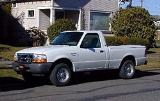
Ford Ranger EV
Encyclopedia
The Ford Ranger EV is a battery electric vehicle
produced by Ford Motor Company
. It was produced starting in the 1998 model year through 2002 and is no longer in production. It is built upon a light truck chassis used in the Ford Ranger
. A few vehicles with lead-acid batteries were sold, but most units were leased for fleet use. A few persistent and interested private parties were able to obtain leases over a period of three to five years. All leases were terminated in 2003-04, and the vehicles were recalled.
battery version was offered, originally exclusively for lease. Some leased Ford Ranger EVs were sold to lessees, however, so there are some Ford Ranger EVs that have been and may be available for purchase as used. The NiMH version delivered a true 65 miles (105 km) range at a steady 65 mph (105 km/h) speed on flat highways (normal operation with some reserve; in comparison the lead-acid version which is said to have a range of up to 65 miles (105 km) with hard tires and careful driving. Actual range of the lead-acid Ford Ranger EV is less). The Ford Ranger EV controller electronics will allow strong acceleration even when in 'E' economy shifter mode. Thus a heavy foot will reduce the EV's range. The above the line cost of this vehicle (before manufacturer discounts and other public agency subsidies) was $52,720.00. Ford Motor Credit supported a generous 3 year lease program that would; along with AQMD (Air Quality Management District) funding and Federal Tax Credits, allow for a RangerEV 3 year lease payment as low as $155. per month. The Lawrence Livermore/Berkeley Labs In Eco-Friendly Northern California signed on for 20 units from Ford Motor Credit with a total lease cost to the Labs of $0. over the 3 year lease term. Thanks to overwhelming financial support from Government funded Clean Cities programs and AQMD Grants, when applied towards an APP (All Payments Paid) version of the RangerEV commercial lease the resulting lease became Paid In Full.
Below are some highlights from the nimh document above:
ACCELERATION 0-50 mph
At 100% SOC: 10.3 sec
At 50% SOC: 11.2 sec
Max. Power: 84.13 kW
Performance Goal: 13.5 sec at 50% SOC
MAXIMUM SPEED @ 50% SOC
At 1/4 Mile: 62.1 mph
At 1 Mile: 74.6 mph
Performance Goal: 70 mph in one mile
CONSTANT SPEED RANGE @ 45 mph3,4,5
Range: 115.0 miles
Energy Used: 27.81 kWh
Average Power: 10.94 kW
Efficiency: 242 Wh/mile
Specific Energy: 57.3 Wh/kg
CONSTANT SPEED RANGE @ 60 mph3,4,5
Range: 74.2 miles
Energy Used: 26.83 kWh
Average Power: 21.52 kW
Efficiency: 362 Wh/mile
Specific Energy: 55.3 Wh/kg
DRIVING CYCLE RANGE3,4,5
Range per SAE J1634: 82.4 miles
Energy Used: 25.95 kWh
Average Power: 8.32 kW
Efficiency: 315 Wh/mile
Specific Energy: 53.5 Wh/kg
Performance Goal: 60 miles
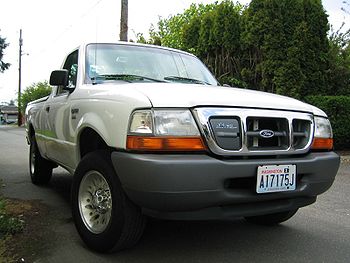
The principal identifiers of an electric Ranger are the appearance of the front charging door in a grille location that is open on ICE (Internal Combustion Engine) Rangers, the missing tailpipe, the Hotchkiss drive
and the visibility of the EV's unique rear suspension and the traction motor from behind the vehicle. From the side, the vehicle is almost indistinguishable from the ICE Ranger except for a modest script Electric on the side. Only the slight projection of the battery trays below the frame rails is noticeable at a distance. Vehicle height is close to that of four-wheel drive vehicles.
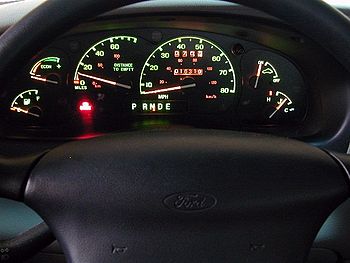
A miles to go indicator to the left of the speedometer is accurate only when the battery system is performing to specification, otherwise it may mislead the driver. A charge indicator at the lower left is in the place of the normal fuel gauge
, but with underperforming batteries, cannot be relied upon owing to its tendency to decline from a full charge to about 3/4 and then drop to empty within a mile or two. Above the state of charge is a rate indicator showing energy usage and recovery.
At the upper right an off-run electric gauge will come up to the run position in a few seconds after Start is commanded by a keyswitch turn. This appears to show the pack voltage applied to the main bus upon start-run relay contact closure and the time delay probably reflects the charging of the motor controller's input capacitors. The vehicle's main contacts will not close until the pre-charge
is complete.
At the lower right a temperature gauge monitors the liquid coolant temperature.
The usual speedometer
and odometer
complete the analog portion of the instrument panel.
Various indicator lights are included, one of which indicates that the truck is plugged in for charging. This is interlocked with the start circuit, disabling it if the Avcon
paddle is inserted.
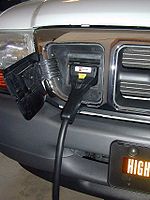 Charging is through an Avcon conductive connector, provided beneath a hinged door to the right side of the grille. A NiMH pack would take six to eight hours to charge, storing about 30 kW·h, and the charging and discharging is regulated through passive control devices.
Charging is through an Avcon conductive connector, provided beneath a hinged door to the right side of the grille. A NiMH pack would take six to eight hours to charge, storing about 30 kW·h, and the charging and discharging is regulated through passive control devices.
. A selector operates similar to that for an automatic transmission with the following positions:
The economy position will reduce the maximum speed available, will also reduce the throttle response, and will engage energy recovery, and so is useful for long downgrades and when approaching a stop or for start and stop traffic. Drive is normally used only for freeway use.
A conventional switch arrangement is used to provide key inserted detection at Off, Accessory, Run, and Start.
Other controls are identical to that of the ICE version.
The heating system uses a ceramic core resistance heater. Air conditioning is provided with an electric-motor driven compressor-condenser-evaporator system.
that located the wheels and which was sprung by the usual longitudinal leaf springs. As the first year production (1998) used lightweight carbon fiber
leaf spring
s, which were insufficiently resistant to transversely locate the DeDion tube, these early versions also contained a Watt's linkage
. Later versions used conventional steel leaf springs and did not require the additional linkage.

 The rear wheels are powered by a six pole alternating current motor operating through a (single speed) three to one reduction transmission and differential. The motor can produce 60 hp and can operate at a maximum speed of 13,000 rpm. The motor, transmission, and differential are contained in a single unit mounted high between the frame rails, transversely between the rear wheels. Half shafts angle downward to drive the wheels.
The rear wheels are powered by a six pole alternating current motor operating through a (single speed) three to one reduction transmission and differential. The motor can produce 60 hp and can operate at a maximum speed of 13,000 rpm. The motor, transmission, and differential are contained in a single unit mounted high between the frame rails, transversely between the rear wheels. Half shafts angle downward to drive the wheels.
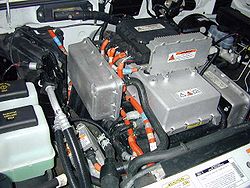 The front underhood compartment contains the charger, an electric air conditioner, the power steering mechanism, the power brake unit (otherwise conventional), a radiator for the air conditioner, and a vacuum pump and reservoir for the power brakes and a reservoir for the windshield washer. Charger and battery liquid cooling service is performed here but is not an owner-operator service item.
The front underhood compartment contains the charger, an electric air conditioner, the power steering mechanism, the power brake unit (otherwise conventional), a radiator for the air conditioner, and a vacuum pump and reservoir for the power brakes and a reservoir for the windshield washer. Charger and battery liquid cooling service is performed here but is not an owner-operator service item.
 To the rear of the rear axle (the usual location for the spare tire) is the AC motor controller. The spare tire could be carried at a station within the truck bed. The spare tire is poorly located within the bed relative to its inefficient use of bed space. Many operators simply did not carry the spare.
To the rear of the rear axle (the usual location for the spare tire) is the AC motor controller. The spare tire could be carried at a station within the truck bed. The spare tire is poorly located within the bed relative to its inefficient use of bed space. Many operators simply did not carry the spare.
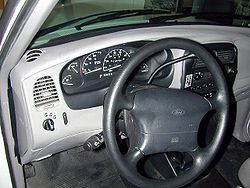 On a very long downhill run one could obtain a noticeably higher state of charge than at the top (3000 ft (914.4 m) elevation difference), so the energy recovery was demonstrably effective.
On a very long downhill run one could obtain a noticeably higher state of charge than at the top (3000 ft (914.4 m) elevation difference), so the energy recovery was demonstrably effective.
Some former NiMH Ranger operators have expressed surprise that any vehicles are being released with NiMH due to the extremely high cost of replacement of cells and packs, while others have pointed out that some NiMH vehicles have run for over 125000 miles (201,167.5 km) on their original battery packs. It is not yet clear what would need to be changed within the vehicle to use other batteries such as PbA or NiCad.
Battery electric vehicle
A battery electric vehicle, or BEV, is a type of electric vehicle that uses chemical energy stored in rechargeable battery packs. BEVs use electric motors and motor controllers instead of, or in addition to, internal combustion engines for propulsion.A battery-only electric vehicle or...
produced by Ford Motor Company
Ford Motor Company
Ford Motor Company is an American multinational automaker based in Dearborn, Michigan, a suburb of Detroit. The automaker was founded by Henry Ford and incorporated on June 16, 1903. In addition to the Ford and Lincoln brands, Ford also owns a small stake in Mazda in Japan and Aston Martin in the UK...
. It was produced starting in the 1998 model year through 2002 and is no longer in production. It is built upon a light truck chassis used in the Ford Ranger
Ford Ranger
The Ford Ranger is a pickup truck produced by the Ford Motor Company. The "Ranger" name had previously been used for a premium styling package on the F-Series full-sized pickup trucks since 1965. The name was moved to this line of North American compact trucks for the 1983 model year.In North...
. A few vehicles with lead-acid batteries were sold, but most units were leased for fleet use. A few persistent and interested private parties were able to obtain leases over a period of three to five years. All leases were terminated in 2003-04, and the vehicles were recalled.
Nickel metal hydride (NiMH) batteries offered
In California and some limited areas outside of California, a NiMH (nickel-metal hydride)Nickel metal hydride battery
A nickel–metal hydride cell, abbreviated NiMH, is a type of rechargeable battery similar to the nickel–cadmium cell. The NiMH battery uses a hydrogen-absorbing alloy for the negative electrode instead of cadmium. As in NiCd cells, the positive electrode is nickel oxyhydroxide...
battery version was offered, originally exclusively for lease. Some leased Ford Ranger EVs were sold to lessees, however, so there are some Ford Ranger EVs that have been and may be available for purchase as used. The NiMH version delivered a true 65 miles (105 km) range at a steady 65 mph (105 km/h) speed on flat highways (normal operation with some reserve; in comparison the lead-acid version which is said to have a range of up to 65 miles (105 km) with hard tires and careful driving. Actual range of the lead-acid Ford Ranger EV is less). The Ford Ranger EV controller electronics will allow strong acceleration even when in 'E' economy shifter mode. Thus a heavy foot will reduce the EV's range. The above the line cost of this vehicle (before manufacturer discounts and other public agency subsidies) was $52,720.00. Ford Motor Credit supported a generous 3 year lease program that would; along with AQMD (Air Quality Management District) funding and Federal Tax Credits, allow for a RangerEV 3 year lease payment as low as $155. per month. The Lawrence Livermore/Berkeley Labs In Eco-Friendly Northern California signed on for 20 units from Ford Motor Credit with a total lease cost to the Labs of $0. over the 3 year lease term. Thanks to overwhelming financial support from Government funded Clean Cities programs and AQMD Grants, when applied towards an APP (All Payments Paid) version of the RangerEV commercial lease the resulting lease became Paid In Full.
Early life problems
There were numerous problems with the NiMH Ranger associated with an inability to accept a charge in hot environmental conditions, and some other problems requiring replacement of major components, but Ford successfully addressed these problems early in the vehicle's life cycle. There were some range issues around the 25000 miles (40,233.5 km) service life with the batteries, and due to the great expense of these batteries, Ford elected not to fix this range problem (as allowed under the lease terms). Some leases were continued despite the shorter range.Performance
According to the Idaho National Engineering Laboratory Advanced Vehicle Testing 1998 Ford Ranger EV(Lead Acid) and 1999 Ford Ranger NIMH(Nickel Metal Hydride)Below are some highlights from the nimh document above:
ACCELERATION 0-50 mph
At 100% SOC: 10.3 sec
At 50% SOC: 11.2 sec
Max. Power: 84.13 kW
Performance Goal: 13.5 sec at 50% SOC
MAXIMUM SPEED @ 50% SOC
At 1/4 Mile: 62.1 mph
At 1 Mile: 74.6 mph
Performance Goal: 70 mph in one mile
CONSTANT SPEED RANGE @ 45 mph3,4,5
Range: 115.0 miles
Energy Used: 27.81 kWh
Average Power: 10.94 kW
Efficiency: 242 Wh/mile
Specific Energy: 57.3 Wh/kg
CONSTANT SPEED RANGE @ 60 mph3,4,5
Range: 74.2 miles
Energy Used: 26.83 kWh
Average Power: 21.52 kW
Efficiency: 362 Wh/mile
Specific Energy: 55.3 Wh/kg
DRIVING CYCLE RANGE3,4,5
Range per SAE J1634: 82.4 miles
Energy Used: 25.95 kWh
Average Power: 8.32 kW
Efficiency: 315 Wh/mile
Specific Energy: 53.5 Wh/kg
Performance Goal: 60 miles
External appearance

The principal identifiers of an electric Ranger are the appearance of the front charging door in a grille location that is open on ICE (Internal Combustion Engine) Rangers, the missing tailpipe, the Hotchkiss drive
Hotchkiss drive
The Hotchkiss drive is a system of power transmission. It was the dominant form of power transmission for front-engine, rear-wheel drive layout cars in the 20th century...
and the visibility of the EV's unique rear suspension and the traction motor from behind the vehicle. From the side, the vehicle is almost indistinguishable from the ICE Ranger except for a modest script Electric on the side. Only the slight projection of the battery trays below the frame rails is noticeable at a distance. Vehicle height is close to that of four-wheel drive vehicles.
Instruments

A miles to go indicator to the left of the speedometer is accurate only when the battery system is performing to specification, otherwise it may mislead the driver. A charge indicator at the lower left is in the place of the normal fuel gauge
Fuel gauge
A fuel gauge is an instrument used to indicate the level of fuel contained in a tank. Commonly used in cars, these may also be used for any tank including underground storage tanks.As used in cars, the gauge consists of two parts:...
, but with underperforming batteries, cannot be relied upon owing to its tendency to decline from a full charge to about 3/4 and then drop to empty within a mile or two. Above the state of charge is a rate indicator showing energy usage and recovery.
At the upper right an off-run electric gauge will come up to the run position in a few seconds after Start is commanded by a keyswitch turn. This appears to show the pack voltage applied to the main bus upon start-run relay contact closure and the time delay probably reflects the charging of the motor controller's input capacitors. The vehicle's main contacts will not close until the pre-charge
Pre-charge
Pre-charge of the powerline voltages in a high voltage DC application is a preliminary mode which current-limits the power source such that a controlled rise time of the system voltage during power up is achieved....
is complete.
At the lower right a temperature gauge monitors the liquid coolant temperature.
The usual speedometer
Speedometer
A speedometer is a gauge that measures and displays the instantaneous speed of a land vehicle. Now universally fitted to motor vehicles, they started to be available as options in the 1900s, and as standard equipment from about 1910 onwards. Speedometers for other vehicles have specific names...
and odometer
Odometer
An odometer or odograph is an instrument that indicates distance traveled by a vehicle, such as a bicycle or automobile. The device may be electronic, mechanical, or a combination of the two. The word derives from the Greek words hodós and métron...
complete the analog portion of the instrument panel.
Various indicator lights are included, one of which indicates that the truck is plugged in for charging. This is interlocked with the start circuit, disabling it if the Avcon
Avcon
Avcon is a company that manufactures charging interfaces for battery electric vehicles . The lettering convention is Avcon for the company and AVCON for the EV charging head....
paddle is inserted.
Charging

Controls
Ford attempted to make the driving and operating experience as similar as possible to that experienced in an ICE vehicle with an automatic transmissionAutomatic transmission
An automatic transmission is one type of motor vehicle transmission that can automatically change gear ratios as the vehicle moves, freeing the driver from having to shift gears manually...
. A selector operates similar to that for an automatic transmission with the following positions:
- Park
- Reverse
- Neutral
- Drive
- Economy
The economy position will reduce the maximum speed available, will also reduce the throttle response, and will engage energy recovery, and so is useful for long downgrades and when approaching a stop or for start and stop traffic. Drive is normally used only for freeway use.
A conventional switch arrangement is used to provide key inserted detection at Off, Accessory, Run, and Start.
Other controls are identical to that of the ICE version.
The heating system uses a ceramic core resistance heater. Air conditioning is provided with an electric-motor driven compressor-condenser-evaporator system.
Battery trays
Batteries are contained in one big battery box that is bolted to the underside of the vehicle. It can be removed using specialized shop equipment. Individual batteries are then serviced and replaced from the open top of the module. The battery layout inside the box is not the same for the Lead-Acid and NiMH battery type. The Lead-Acid setup is using 39 x 8V batteries setup on two layers. The NiMH setup is using 25 x 12V batteries on one layer. The Lead-Acid setup has a weight of 2000 lb (907 kg). As for the NiMH setup, it only weighs 1050 lb (476 kg).Battery heating
The lead-acid batteries are sensitive to temperature, losing a substantial portion of capacity in winter conditions. When plugged in for charge the battery temperature is sensed and battery heaters used to maintain temperature sufficient to retain specified range - a necessity for colder climate fleet use, where vehicles are usually parked outdoors. This would suggest that to enhance the economy of use in such climates that the vehicle should be sheltered. NiMH batteries do not have this temperature sensitivity; however, models with NiMH batteries do have a loss in range in cold temperatures, perhaps because of greater rolling resistance in the drive train and tires. NiMH pack consists of 25 Panasonic EV-M95, 12.00 Volt, Nickel-Metal Hydride batteries. NiMH pack voltage range Empty 280Vdc - Full 350Vdc.Battery cooling
The ability to charge NiMH batteries is limited by heat gain, so these batteries are air-cooled by two fans. The first fan is circulating the air around the batteries. The second fan is exchanging the air inside the battery box.Rear suspension
The rear suspension consists of a De Dion tubeDe Dion tube
A de Dion tube is an automobile suspension technology. It is a sophisticated form of non-independent suspension and is a considerable improvement over the alternative swing axle and Hotchkiss drive types. A de Dion suspension uses universal joints at both the wheel hubs and differential, and uses a...
that located the wheels and which was sprung by the usual longitudinal leaf springs. As the first year production (1998) used lightweight carbon fiber
Carbon fiber
Carbon fiber, alternatively graphite fiber, carbon graphite or CF, is a material consisting of fibers about 5–10 μm in diameter and composed mostly of carbon atoms. The carbon atoms are bonded together in crystals that are more or less aligned parallel to the long axis of the fiber...
leaf spring
Leaf spring
Originally called laminated or carriage spring, a leaf spring is a simple form of spring, commonly used for the suspension in wheeled vehicles...
s, which were insufficiently resistant to transversely locate the DeDion tube, these early versions also contained a Watt's linkage
Watt's linkage
Watt's linkage is a type of mechanical linkage invented by James Watt in which the central moving point of the linkage is constrained to travel on an approximation to a straight line...
. Later versions used conventional steel leaf springs and did not require the additional linkage.

Driveline

Tires and wheels
All wheels including the spare are made of cast aluminum. Tires are low rolling resistance, similar to what would be found on a full-size sedan, rather than on a truck. 1998 and 1999 wheels were of the same, simple design. Later models had wheels of a large 'spoke' design.Component layout


Bed cover
In the interest of improved aerodynamics the bed is covered by a snap on cover supported by aluminum bows. Snap receivers slide within aluminum channels. A rear bow allows the tailgate to be opened without removing the cover. The cover can be quite difficult to re-snap under cold conditions due to shrinkage and stiffness of the vinyl material. As the bed was a carryover from the standard Ford Ranger body, some owners opted for after-market tonneau covers, such as hard fiberglass or roll-top.Charger, battery, and motor controller thermal management
The power electronics such as the motor, motor controller, AC motor controller, and high voltage DCDC converter are liquid-cooled. The batteries and battery charger are air-cooled.Energy recovery

Economy
Power consumption for light duty suburban use is around 500 watt-hours per mile, both by the EPA figures for early models and by some owners' experience.Controversy and lottery
It was expected that Ford, like other companies, would completely destroy almost all remaining stocks by crushing, as has been done by several other major vehicle manufacturers. This plan engendered considerable resistances from electric vehicle fans, with the adverse publicity prompting a change in Ford's policy. This change of policy appears to have also influenced Toyota not to destroy all of its leased RAV-4 electrics. Also a persistent few of Ford's lease return resistors (some of whom were actually allowed to buy the vehicle under terms of their lease arrangements by the dealer's use of a non-specific lease form) were allowed to purchase their vehicles for one dollar. While most of the 1,500 vehicles produced have been destroyed, a number of Ranger EVs have been parted out for spares and the remaining several hundred units have been refurbished (using selected used and new old stock batteries) and other salvage components (both with lead-acid and NiMH batteries) by a third party company (Blue Sky Motors of Sacramento, California).Some former NiMH Ranger operators have expressed surprise that any vehicles are being released with NiMH due to the extremely high cost of replacement of cells and packs, while others have pointed out that some NiMH vehicles have run for over 125000 miles (201,167.5 km) on their original battery packs. It is not yet clear what would need to be changed within the vehicle to use other batteries such as PbA or NiCad.

